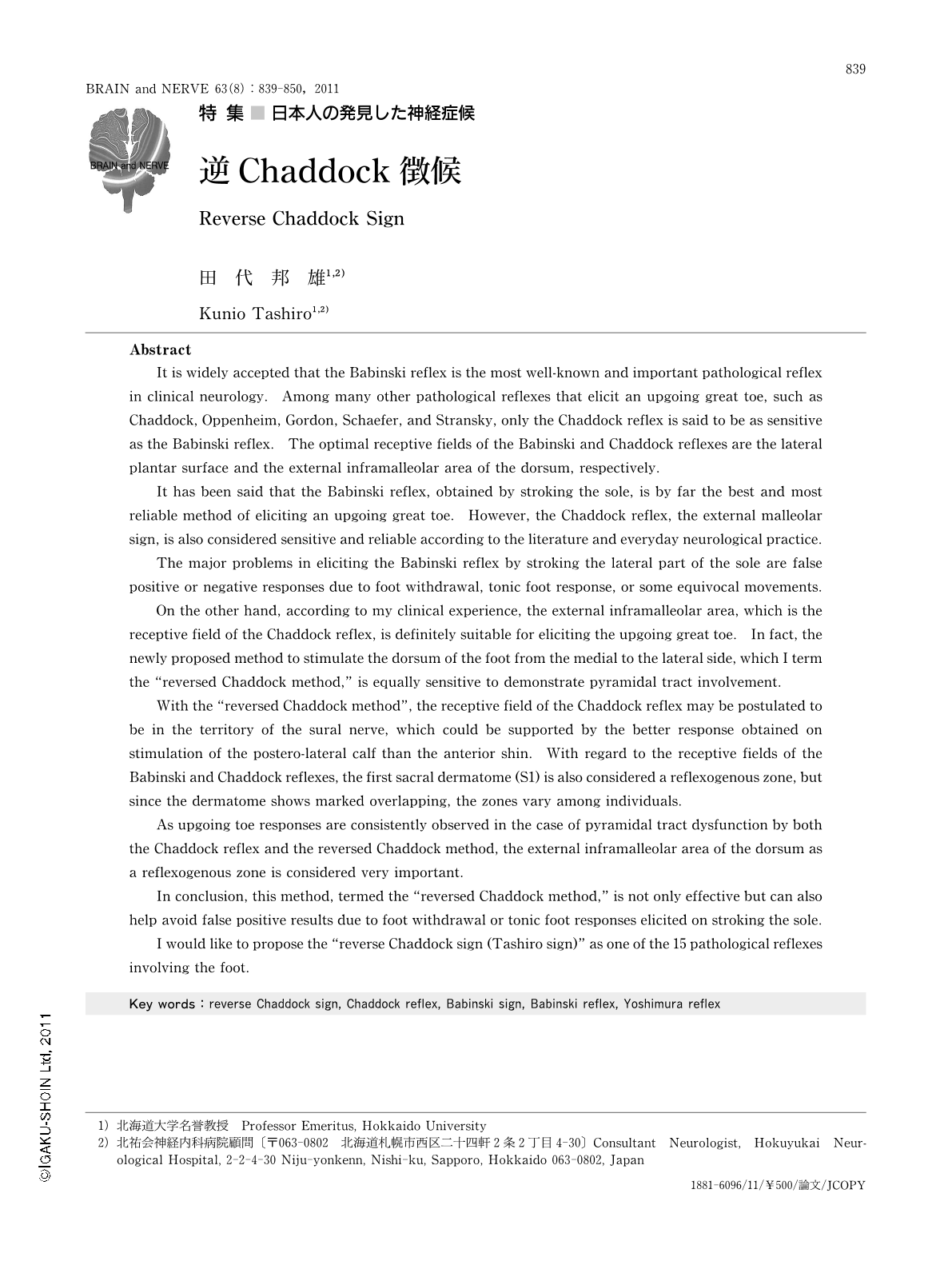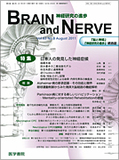Japanese
English
- 有料閲覧
- Abstract 文献概要
- 1ページ目 Look Inside
- 参考文献 Reference
はじめに
Babinski反射は神経学における最も重要な反射であり,1896年にJoseph Babinski1)が発表した28行の論文が,その後の神経学に大きな影響を与える画期的なepochとなったことは内外の文献で詳しく紹介されているところである2,3)。この「足底外側を刺激することで母趾が背屈する」という現象は,錐体路の障害を意味する。
Babinskiの報告以来,母趾を背屈させる刺激法が次々と発表され,その後,それぞれの人名を冠した反射として今日まで伝わってきているが,“Babinski反射が唯一のものであり,他は単なるその変法にすぎず,またその出現率も低い”ということが一般的見解ともされてきた。
しかしながら,神経学の臨床の場においてChaddock反射がBabinski反射に負けず劣らずよく誘発できることも事実であり,時折Babinski反射の出現が“気まぐれ(capricious)”で判定が困難な場合にも,Chaddock反射は確実に陽性となり,錐体路の障害を確定できた経験を持つ方々も多いのではないだろうか。
Babinski反射やChaddock反射が陽性であるか否かによって,その神経疾患の診断や治療に大きな影響があり,したがって,いかに正確にこれらの反射を誘発するかが神経学の臨床に携わる者の実力として問われるところでもある。医学の領域に新しい補助検査法が導入されるたびに,その分野の飛躍的発展が期待されるが,その一方では基本的な診察が疎かにされる傾向があることも否定できない。しかし,神経学においては,特に診察室やベッドサイドでの神経学的診察が今でも最も重要で,1人の患者に多くの時間を費やし神経症候を正確に把握することが求められるのである。Babinski反射やChaddock反射は霊長類でのみ出現するとされているため,その臨床的追究および研究は直接人間において行われるべきものであり,その神経症候学的意義は大きいといえるであろう。
本稿では,Chaddock反射(Chaddock徴候)の検討の過程において,“逆Chaddock徴候(reverse Chaddock sign)”を提唱するに至った経緯とその意義について報告する。
Abstract
It is widely accepted that the Babinski reflex is the most well-known and important pathological reflex in clinical neurology. Among many other pathological reflexes that elicit an upgoing great toe, such as Chaddock, Oppenheim, Gordon, Schaefer, and Stransky, only the Chaddock reflex is said to be as sensitive as the Babinski reflex. The optimal receptive fields of the Babinski and Chaddock reflexes are the lateral plantar surface and the external inframalleolar area of the dorsum, respectively.
It has been said that the Babinski reflex, obtained by stroking the sole, is by far the best and most reliable method of eliciting an upgoing great toe. However, the Chaddock reflex, the external malleolar sign, is also considered sensitive and reliable according to the literature and everyday neurological practice.
The major problems in eliciting the Babinski reflex by stroking the lateral part of the sole are false positive or negative responses due to foot withdrawal, tonic foot response, or some equivocal movements.
On the other hand, according to my clinical experience, the external inframalleolar area, which is the receptive field of the Chaddock reflex, is definitely suitable for eliciting the upgoing great toe. In fact, the newly proposed method to stimulate the dorsum of the foot from the medial to the lateral side, which I term the "reversed Chaddock method," is equally sensitive to demonstrate pyramidal tract involvement.
With the "reversed Chaddock method", the receptive field of the Chaddock reflex may be postulated to be in the territory of the sural nerve, which could be supported by the better response obtained on stimulation of the postero-lateral calf than the anterior shin. With regard to the receptive fields of the Babinski and Chaddock reflexes, the first sacral dermatome (S1) is also considered a reflexogenous zone, but since the dermatome shows marked overlapping, the zones vary among individuals.
As upgoing toe responses are consistently observed in the case of pyramidal tract dysfunction by both the Chaddock reflex and the reversed Chaddock method, the external inframalleolar area of the dorsum as a reflexogenous zone is considered very important.
In conclusion, this method, termed the "reversed Chaddock method," is not only effective but can also help avoid false positive results due to foot withdrawal or tonic foot responses elicited on stroking the sole.
I would like to propose the "reverse Chaddock sign (Tashiro sign)" as one of the 15 pathological reflexes involving the foot.

Copyright © 2011, Igaku-Shoin Ltd. All rights reserved.


